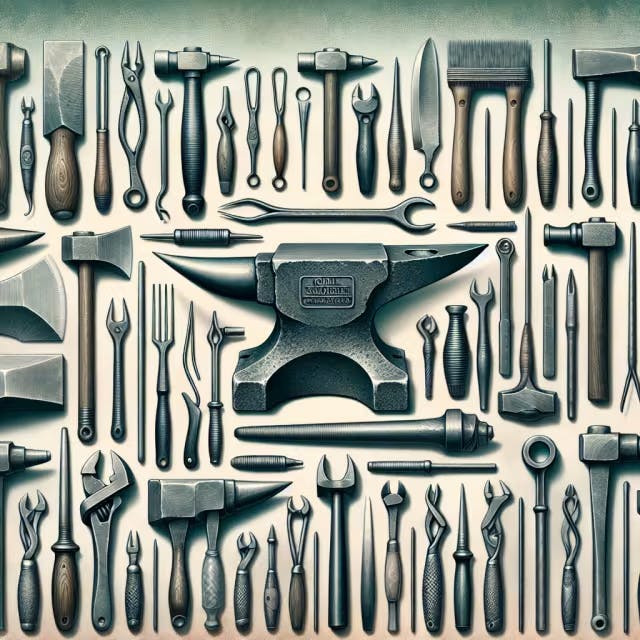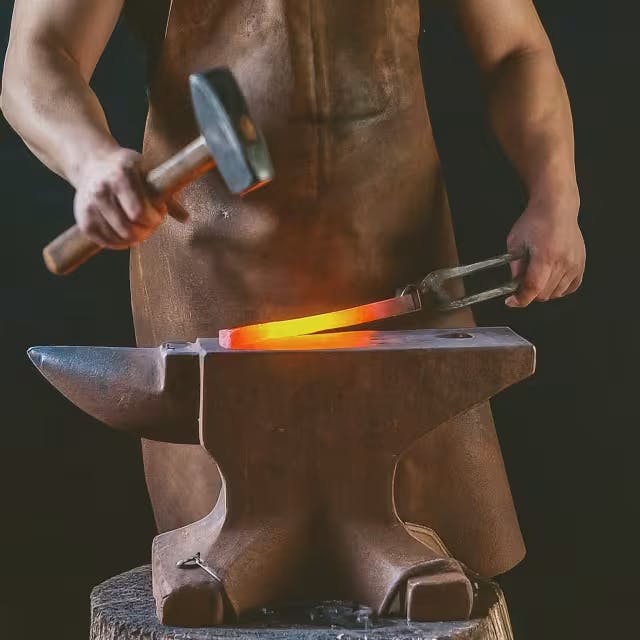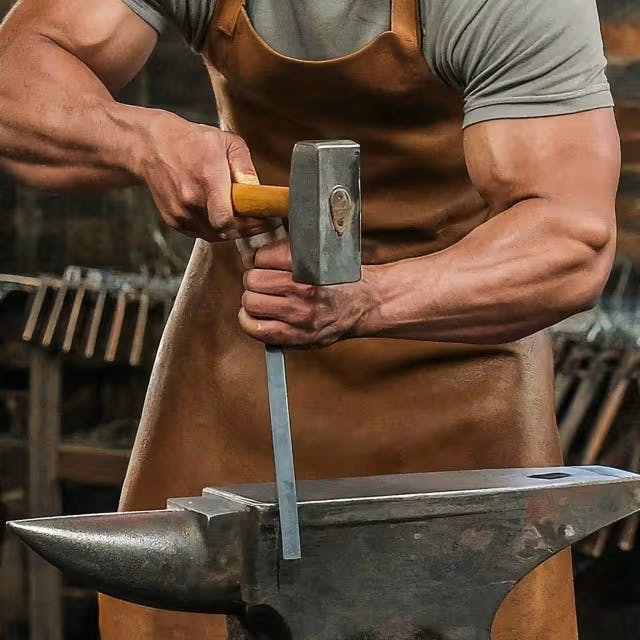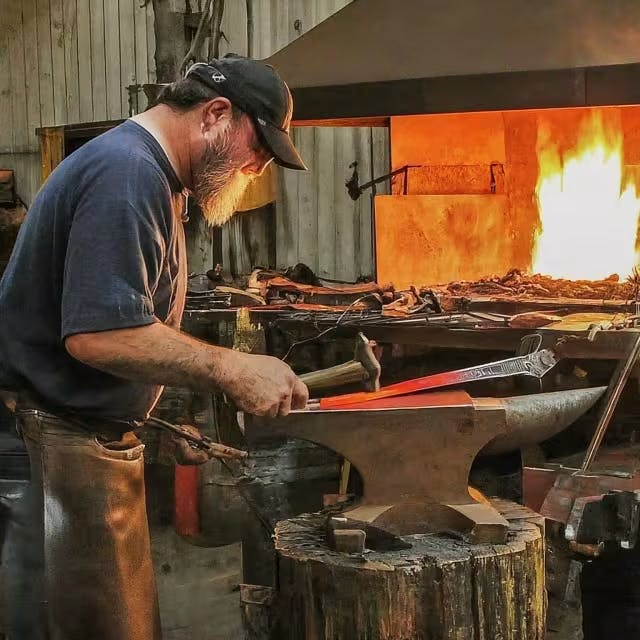Anvil Hardy Tools for Blacksmithing
Abana Chapter
February 21, 2024

Stepping into the workshop of a smith, you'll quickly notice the essential role played by the square-shanked wonders known as anvil hardy tools for blacksmithing. These specialized metalworking tools, including the fundamental hardy chisel, bending drifts, and swages, slot seamlessly into an anvil's hardy hole, anchoring them in place for robust metal shaping and forming tasks. Whether stretching metal with fullers, crafting cross-section specific bolts with swages, or employing a combination of hardy and corresponding top tools to achieve precise angles, these versatile instruments are a blacksmith’s best friend in manipulating metal to their creative will.
Key Takeaways
Anvil hardy tools, such as the hardy chisel, bending drifts, and swages, are essential for metalworking and fit into an anvil's hardy hole for stability during metal shaping tasks.
These tools serve a broad range of purposes in blacksmithing, from stretching metal with fullers to forging specific bolt cross-sections with swages, to achieving precise angles with a combination of hardy and top tools.
Hardy tools are a blacksmith's best friend due to their versatility, allowing for creative manipulation and forming of metal in various ways.
It's important to select the appropriate hardy tool for a project to get the best results; understanding the metal type and the desired final shape is critical.
Regular maintenance is vital for hardy tools, which involves proper cleaning, sharpening, and storage techniques to ensure their longevity and performance.
Familiarizing oneself with the different types of hardy tools and their specific uses can significantly enhance a blacksmith’s ability to tackle a wide array of projects with precision and efficiency.

Understanding Anvil Hardy Tools: A Blacksmith's Best Friend
Anvil hardy tools are essential for blacksmiths who shape and work metal. Designed to fit snugly into the hardy hole of an anvil, these specialized tools come in various types, each serving a specific purpose in the metalworking process. Here are some of the most commonly used hardy tools:
Tool Type | Description |
Cut-off Hardy | Used for cutting hot metal on the anvil without damaging the surface. |
Bending Fork | Allows blacksmiths to bend and manipulate metal into different angles. |
Fuller | Employed to create grooves or spread metal efficiently while forging. |
Hot Chisel | Designed to cut and shape hot metal, providing a clean-cut edge. |
Each tool is crafted for durability, typically made from high-carbon steel for longevity and resistance to wear. Knowing the correct use and maintenance of these tools can greatly enhance the efficiency and craftsmanship of blacksmithing projects.
To extend the life of these tools, proper maintenance, including cleaning and occasional oiling, is recommended. Selecting the right hardy tool from trusted suppliers ensures that blacksmiths can rely on them for precise work and craftsmanship.
To explore a variety of anvil hardy tools and find the best fit for your blacksmithing needs, you can visit premium suppliers for professional-grade tools. Here, you'll find tools tailored to various tasks that can help expand your skillset and enable you to execute complex designs with precision.

Essential Hardy Tools Every Blacksmith Should Have
Blacksmithing requires a diverse set of tools to shape, cut, and manipulate metal, and among these, anvil hardy tools play a crucial role. The hardy hole of the anvil—a square socket—is designed to hold various hardy tools, which perform specific tasks that are indispensable for any serious metalworker.
Hardy Tool | Function |
Cutting Hardy | Used for cutting hot metal on the anvil |
Bending Fork | Helps in bending bars of different sizes |
Hardy Hot Cut | Enables precise cutting at high temperatures |
Fuller | Used for necking down steel, making grooves |
Cutting Hardy: This essential tool has a sharp edge designed to assist in severing heated metal with ease. For a clear-cut severance, it's inserted into the hardy hole, and the blacksmith strikes the soft metal over this edge, making the cutting process more efficient and safe compared to using hand tools.
Bending Fork: Crafted to support a range of bending techniques, the bending fork's prongs accommodate various bar sizes. It's clamped to the anvil, providing leverage and an anchor point to bend metal bars into precise shapes and angles.
Hardy Hot Cut: When working with high-temperature metals, the hardy hot cut is pivotal. Unlike its cold-cut counterpart, this tool can withstand the thermal stress from hot forging, maintaining its sharpness and durability over time.
Fuller: Used for drawing down and spreading metal, fullers come in different curves and sizes to match the depth and width of grooves required. Fullers accomplish the task of creating rounded indentations, aiding in the control of metal flow during the forging process.
Equipping your workshop with a well-rounded set of hardy tools can expand your blacksmithing capabilities, enabling you to tackle a wider array of projects with precision and efficiency. For a more detailed understanding of these tools and their applications, professional resources can provide invaluable guidance to both novice and experienced blacksmiths alike.

The Versatility of Hardy Tools in Blacksmithing
Anvil hardy tools are indispensable assets in the blacksmith's arsenal, offering a diverse range of functions to shape metal effectively. These tools, often simply inserted into the hardy hole of an anvil, provide an expedited method for various tasks such as cutting, bending, and forming metalwork.
Hardy Tool | Use Case |
Hot Cut Hardy | Slices through hot metal |
Bending Fork | Precise angles and curves |
Fuller | Groove and shape metal |
Swage Block | Form concave or convex shapes |
Experienced blacksmiths often have a selection of hardy tools, each designed for specific blacksmithing tasks. For instance, the hot cut hardy enables efficient cutting without the need for a handheld chisel, minimizing effort and improving precision. When intricate bends are necessary, the bending fork comes into play, allowing smiths to navigate complex angles with its pronged ends. Fullers create grooves or spread material, essential for decorative detail or joint work. Additionally, swage blocks are multipurpose, with cavities perfect for forming various curves or angles in metal pieces.
These tools are crafted from high-carbon steel to ensure longevity and withstand the stresses of metal manipulation. The versatility of anvil hardy tools is a testament to their enduring relevance in metalwork, and their capability to adapt to modern applications underlines their importance for both novice and skilled blacksmiths. By investing in a comprehensive set of hardy tools, artisans can significantly enhance their craftsmanship and expand their creative horizons.
Selecting the Right Anvil Hardy Tool for Your Project
When you're in the market for anvil hardy tools, understanding each type's application is crucial. A hot cut hardy is designed for slicing through hot metal on an anvil and often comes in varying blade widths. On the other hand, a cold cut serves similar purposes but is adapted to colder metals. For shaping metals into distinct forms, a bending hardy with its V or U-shaped notch is indispensable. Let's consider the specifications of each tool to help you make an informed decision.
Tool Type | Purpose | Key Features |
Hot Cut Hardy | Cutting hot metal | Sharp blade, varying widths, durable construction |
Cold Cut Hardy | Cutting cold metal | Robust composition, sharp edge, long-term endurance |
Bending Hardy | Shaping metal into curves and angles | V or U-shaped notch, variable sizes |
For instance, if your projects often include intricate metal bending, a bending hardy is a must-have due to its tailored design for such tasks. However, for general cutting work, a versatile hot cut hardy should be enough to start with.
Always assess the shank size of the hardy tool to ensure compatibility with your anvil's hardy hole. Mismatched sizes can lead to tool instability or damage. Furthermore, consider the quality of the steel used. High-grade steel ensures longevity and reduces the need for frequent replacements.
For current selections and availability, it's recommended to regularly check reputable online suppliers. As you browse, you might find additional tools like the fuller or swages that further diversify your metalwork capabilities. Each product description will highlight the tool's suitability for various tasks, simplifying your selection process.
Remember to don suitable safety gear when working with these tools, as safety should never be compromised. Gloves, safety glasses, and a productive work environment contribute to both crafting excellence and personal well-being.
Understanding the Different Types of Hardy Tools
When selecting anvil hardy tools for blacksmithing, a blacksmith must consider not only the type of metalwork they are doing but also the specifics of the tools that best suit the job. Below are key categories to consider:
Cutting Hardy: Ideal for shearing off excess metal, these tools usually have a sharp edge suited for precision work. Be sure to check the durability of the cutting edge to ensure it can withstand repeated use on heated metals.
Scroll Hardy: Crafted to assist in the formation of scroll shapes in metalwork, this variant features a curved shape that helps control the bend and flow of metal as it's shaped into scrolls.
Punching Hardy: With this tool, a blacksmith can easily punch holes through metal with a hammer blow. Its design focuses on concentrating force to create clean, round holes with minimal effort.
While these are some of the basic types, other specialized tools can be found, each offering unique attributes that facilitate specific metalworking techniques. To visualize the common types, refer to the table below:
Tool Name | Primary Use | Distinguishing Feature |
Cutting Hardy | Shearing metal | Sharp edge, high durability |
Scroll Hardy | Forming scroll shapes in metal | Curved design for easy bending |
Punching Hardy | Creating holes in metal | Concentrated force for clean holes |
Explore our selection of hardy tools to find the right match for your anvil and projects. Ensure that each tool fits your anvil's hardy hole properly to maintain safety and achieve precise results. Quality material composition like high-carbon steel can significantly extend the life and performance of your tools, making them a wise investment for any blacksmith.

Maintaining Your Hardy Tools: Tips and Techniques
To keep anvil hardy tools for blacksmithing in optimal condition, regular maintenance is crucial, similar to how pruning trees and shrubs promotes their health and structure. For anvil tools, rust prevention is vital; apply a light coat of oil after each use. Store them in a dry environment to minimize exposure to moisture.
Sharpen cutting edges as needed to ensure clean and efficient cuts during forging. This involves using a file or grinder, followed by honing with a sharpening stone to refine the edge. Regular inspection helps identify nicks or wear that can impede performance.
For tools with moving parts, such as tongs or fullers, lubrication helps maintain smooth operation. Use a suitable mechanical lubricant on any pivot points or threaded components.
Lastly, assess the condition of wooden handles and replace them if they show signs of cracking or weakening. Tightening or replacing loose or worn components extends the life of your tools and improves safety.
By adhering to these simple care techniques, blacksmiths can ensure their anvil hardy tools remain a reliable extension of their craft. In conclusion, anvil hardy tools for blacksmithing are essential implements that complement the creativity and skill of the artisan. By understanding the various types available, such as Cut-off Hardies, Bending Forks, Fullers, and Hot Chisels, and implementing routine maintenance, blacksmiths can greatly enhance the quality and efficiency of their work. Whether you're a seasoned professional or a beginner, investing in the right hardy tools and caring for them properly is an investment in the craft of blacksmithing that pays dividends in the form of better workmanship and longer-lasting tools.
Frequently Asked Questions
What are the most essential Anvil Hardy Tools for blacksmithing?
The most essential Anvil Hardy Tools for blacksmithing include:
Cut-off Hardy: Used for efficiently cutting hot metal on the anvil, protecting the anvil face from damage.
Bending Fork: Allows for precise bending and manipulation of metal into different angles and shapes.
Fuller: Employed for creating grooves or spreading metal, enabling more detailed work during forging.
Hot Chisel: Designed for cutting and shaping hot metal, ensuring clean-cut edges.
Proper use and maintenance of these tools are key to their longevity and effectiveness in blacksmithing projects.
How do Cut-off Hardy tools enhance metal cutting on the anvil?
Cut-off Hardy tools enhance metal cutting on the anvil by providing a dedicated, sharp edge that aligns with the anvil's surface, enabling blacksmiths to cut hot metal efficiently without damaging the anvil itself. Here's how they contribute to the process:
Sharp Edge: The cut-off Hardy has a sharp edge that cuts through heated metal with precision, making clean cuts easier and reducing the physical effort required compared to hand tools.
Fit to Anvil: Designed to fit snugly into the hardy hole, this ensures stability and safety during use, as the tool doesn't move or slide while striking metal.
Durable Construction: Typically made from high-carbon steel, cut-off Hardy tools are built to last and withstand the high temperatures and forces of cutting metal on the anvil repeatedly.
This precision and durability of cut-off Hardy tools significantly enhance the efficiency, effectiveness, and safety of metal cutting operations on the anvil for blacksmiths.
Why should blacksmiths use a Bending Fork for manipulating metal
Blacksmiths should use a Bending Fork for manipulating metal because:
It provides an effective way to create precise angles and bends in metal bars of varying sizes, offering the leverage needed for intricate shaping.
The design of the Bending Fork with its prongs allows for a secure grip on the metal, ensuring consistency and accuracy in the forming process.
Using the Bending Fork along with an anvil's hardy hole allows the blacksmith to work efficiently, saving time and effort compared to manual bending methods.
What is the function of a Fuller in blacksmithing
In blacksmithing, a Fuller is a type of hardy tool that is used to create grooves or to spread metal. Fullers come in different curves and sizes to suit the specific dimensions of the groove needed or to control the flow of metal when forging. They are important tools for creating rounded indentations and are key in processes such as necking down steel or forming shoulders on pieces being worked.
How does a Hot Chisel provide clean-cut edges in hot metalwork
A hot chisel, specifically designed for metalwork, allows for clean-cut edges in hot metalwork by using several key characteristics:
Crafted from High-Carbon Steel: This material has high resistance to wear and maintains a sharp edge, even at high temperatures, ensuring precise cuts.
Designed for the Anvil Hardy Hole: Fit into the secure and sturdy square hole (the hardy hole) on an anvil, providing stability and support for strong, controlled blows.
Properly Maintained Edge: Regular sharpening and maintenance keep the hot chisel in optimal condition, ensuring that each cut is clean and reducing the chance of jagged edges.
Through the combination of material properties, design specific to the anvil, and maintenance, a hot chisel can consistently provide clean-cut edges in hot metalwork.
Where can blacksmiths find professional-grade Anvil Hardy Tools for their projects?
Blacksmiths can find professional-grade Anvil Hardy Tools for their projects at specialized suppliers or online retailers such as Centaur Forge and Blacksmiths Depot. These vendors offer a wide selection of hardy tools, including cut-off hardies for cutting hot metal, bending forks for manipulating metal into angles, fullers for creating grooves, and hot chisels for shaping hot metal. Proper maintenance, including regular cleaning and oiling, is recommended to maintain their durability and ensure safety. It is also essential to select tools that appropriately fit the hardy hole of one's anvil and are made of high-carbon steel for longevity and resistance to wear. For guidance on the use and upkeep of these tools, professional resources are available that can help both beginners and experienced blacksmiths enhance their craftsmanship.


